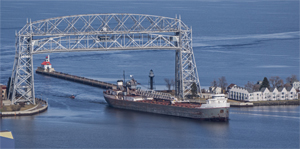Great Lakes pilotage rates for 2018 are the target of a new lawsuit alleging the U.S. Coast Guard set rates too high without a mechanism to deal with overcharges. The litigation follows a similar lawsuit covering two previous years that is still in dispute.
In November, a coalition of shipping industry groups led by the American Great Lakes Ports Association filed suit in federal district court to overturn the 2018 pilot rates set by the Coast Guard. According to the AGLPA, the 12.7 percent increase was the fourth double-digit rate hike in a row, following increases of 14 percent, 24 percent and 20.1 percent in the three previous years.
The same shipping coalition prevailed on two key counts in its challenge of the 2016 rate setting. In that case, a federal judge agreed that the Coast Guard had “acted arbitrarily in setting the target compensation for pilots, and had failed to take into account vessel weighting factors” when calculating the rates. The coalition said the errors resulted in millions of dollars of overpayments during the 2016 navigation season and portions of the 2017 season. The court currently is considering possible remedies in the lawsuit involving those two years.
In addition to the AGLPA, the coalition includes the Shipping Federation of Canada, the U.S. Great Lakes Shipping Association, and vessel operators Fednav, Polsteam, Canfornav, Wagenborg, Spliethoff and Brochart. The November suit alleges the Coast Guard improperly set rates for 2018 in a manner that was “arbitrary and capricious” and in violation of the Administrative Procedures Act. The 2018 rate setting went into effect July 5.
The 2018 ruling set the average per-pilot compensation figure at $325,100 including mandatory overtime and compensation for on-call time based on a 270-day working season. The suit claims the average pilot’s season is closer to 200 days due to mandated rest days. The rates were based on the Coast Guard’s assertion that a Great Lakes pilot should earn 1.5 times the salary of a first mate on a U.S.-flagged Great Lakes vessel based on 2015 American Maritime Officers union contract rates.
Rates for Canadian pilots, who are government employees rather than independent contractors, are about half that of U.S. pilots under the 2016 formula.
To develop projections for compensation, the Coast Guard uses a 10-year moving average of traffic levels, but looks at operating expenses on a three-year basis and pilot staffing levels on a one-year basis. The 10-year average includes periods of depressed traffic volume and a corresponding reduction in bridge hours for pilots, which leads to unrealistically low revenue projections for pilot associations as traffic volumes have recovered.
The November lawsuit also alleges that the Coast Guard failed to take into account industry comments before issuing the final rule for 2018, and that the regulations don’t have a provision for refunding or crediting ratepayers for fees that exceed expected levels. The suit alleges that the Coast Guard responded to concerns about chronic overcollection of revenue as “not a highly salient issue at this time,” and appeared to attribute overcollection to “higher traffic than expected.”
The shipping coalition suit asks the court to set aside the 2018 final rule, direct the Coast Guard to calculate new rates for 2018, and require future rates to be set to avoid overcollection of pilotage fees.

